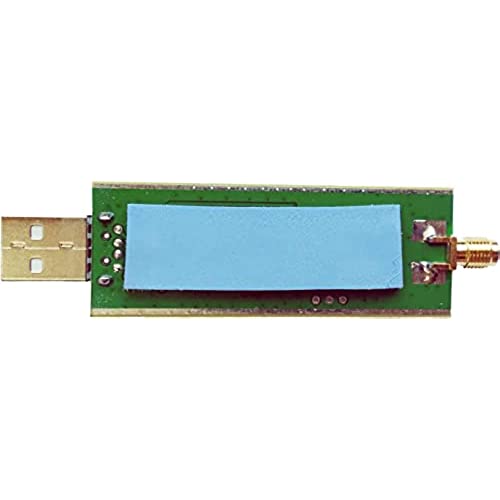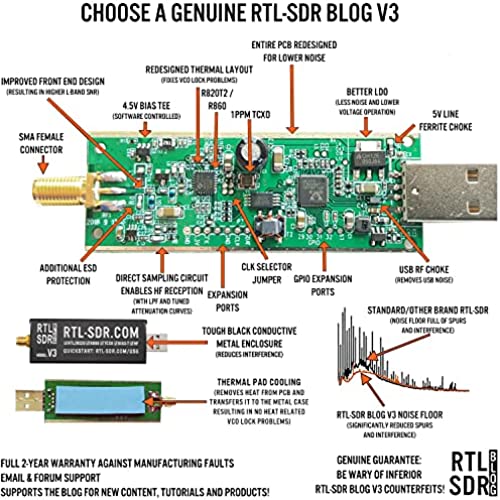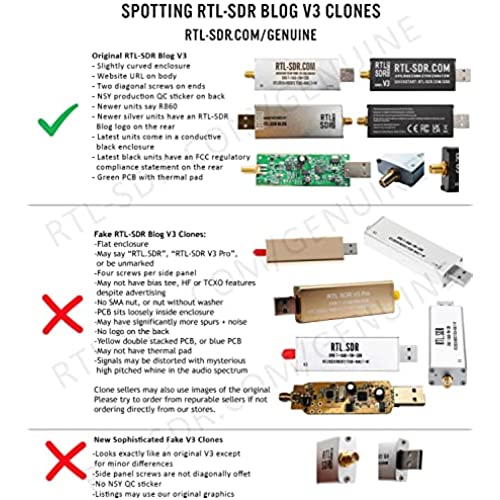













RTL-SDR Blog V3 R860 RTL2832U 1PPM TCXO SMA Software Defined Radio (Dongle Only) (Black)
-

Richard2519
> 3 dayBe sure to find the Quick-start guide which explains how to install the software and get started. It saved me a ton of time figuring things out. Next, be patient. Youll find that little bits of the frequency range will keep you entertained. HAVE FUN!
-

Jim or Dot
> 3 dayWorks great. As advertised. This is the most fantastic device I have used in a very long time. This hardware device enables your computer to see radio signals. Associated software enables you to process (tune) those signals in a variety of ways. To be able to continuously tune 500 KHz to 1.7 GHz is astounding in itself. Throw in a RF Spectrum Analyzer, Audio Spectrum analyzer and assorted filters and it is mind blowing. And the software is free (donations accepted). This is incredible. To do this a few years ago would have cost tens of thousands of dollars. If there were 10 stars I would pick 10 stars. Dont expect a simple thing. Using this device involves unlimited options and radio/science and thus it is not necessarily intuitive :)
-

bob g
Greater than one weekpretty cool little bugger, never used one before so i am still learning be aware they run hot, not hot enough to burn your fingers or anything, but one might think something is wrong when that is just how hot they are in operation. i bought a ham it up unit to down convert so that i could receive sw and ham bands below 25mhz along with the AM broadcast bands, without which this unit does not have the ability to resolve. also have to download the drivers and software to make it work on your computer, i use it with windows 10 and youtube smokingape or smokinape is your friend when it comes to getting this thing running. i am using it with a 9:1 balun and a 30ft long wire antenna inside so it is not at all optimal, but it seems to work for proof of operation. my next move will be getting a better antenna and mounting it outside. my use will be in the shortwave bands. so far it is great on the FM broadcast band, and with my poor antenna ok on AM broadcast, and somewhat works on shortwave below about 11mhz or so... i think the antenna is the shortfall. i would recommend it to anyone wanting to try an sdr
-

J. B.
> 3 dayThis is my 3rd SDR, first of this design. The case doesnt vent and it gets intensely overheated. If you are savvy you can write your own programs with auto shutdowns for cool off periods. But it cools slowly, no venting, not well heatsink. It will spend more time off than on. If you just let it run, it will cook itself to death. Either ingot a bad unit or this design is garbage.
-

Jay Dub
> 3 dayI have 2 of these units. I was surprised at how hot they run. I always thought the heat would kill them and here I am a year after buying them and I have 2 dead units. They do not hold up well over the long term. Other than their short life theyve worked well as they feed a private audio stream of P25 communications.
-

Gunther Kastenholz
> 3 dayI was looking at expensive scanners when I read about software defined radio and figured, for the price, why not give it a try? If Im not happy Im out less than $30, if I am happy I just saved hundreds. So far, Im happy! Having lots of fun messing around with the app they recommend on their website. Separately, I bought their little antenna kit and mounted it to my office window. My wife comes home and immediately says nerd alert!!! which means whatever I did must actually be awesome. I thought it would take a lot longer to set up but I got the basic config done pretty quick with their faq page and was listening to my local first responder frequencies in under 30 minutes.
-

Bowley
Greater than one weekThis Software Defined Radio is the best bang for buck out of any SDR out there. I have worked with SDRs every day for about 3 years now, but those are several thousand dollars each. This was my first low cost SDR and I was very dubious of the performance and software. However, it arrived well packaged and was easy to install following the short instructions on the RTL SDR blog. The software runs seamlessly on my Windows 10 surface pro 3 and doesnt use much CPU at all. Within 6 minutes using SDR# software I had already tuned into several perfectly clear AM radio stations and then listened in on a HAM radio conversation. I found plenty more interesting signals, including a local automated weather broadcast. Next I plan to start on ADSB signals from aircraft and then maybe satalyte data. There are some things that need improving but dont get in the way: •The SMA connector feels delicate and probably wont last forever. I dont recommend adding your own soldering as mentioned in other reviews as it will spoil the impedance matching and thus sensitivity. •It runs hot, but not too hot. •its heavy for a USB dongle vs memory sticks etc. This causes it to sag in the vertical USB port on the Surface and if I moved too quickly it could fall out from its own weight. Overall $20 very well spent!
-

Brent
> 3 dayI had previously bought one of the cheep RTL-SDR receivers for $20 when they came out just to try it out. For the price of this, it is a very good deal. I received it, unplugged my old and plugged in this one and it worked perfectly. I love the work they have done on the front end of this receiver, it makes a big difference on reception, also all around changes that make this RTL-SDR a very good improvement over my first one. I recommend this receiver for anyone wanting to get into, or see what RTL-SDR is all about. For the money, its the best deal I have found.
-

L K
> 3 dayI have two SDR dongles that worked on an earlier version of my Linux Mint OS (19.1, 19.3) but did not work on version 20 with the instructions I had. However, after I purchased the RTL-SDR Blog 3, its instructions got it up and running. And now even my other dongles work on Linux Mint 20! An SDR is a software-defined radio that uses the RTL-SDR chip to tune anything from 24.5 MHz up to around 1900 MHz. It is capable of receiving AM, FM, Single Sideband, and Morse code communications signals. In addition, it supports FM stereo broadcasting along with analog TV sound broadcasting. Unfortunately, you cannot use this SDR to see or hear digital TV in North America. I have listened to FM broadcasts, ham radio FM repeaters, and the National Weather Service FM on 162.55 MHz. That is all using a handheld radios long antenna for 2m and 70cm ham bands laying horizontally in my bedroom. The radio reception can be much better, of course, with a good antenna outdoors. However, you must guard against damage to the chip and your computer by not connecting to an outdoor antenna during foul weather. If you have access to a decent antenna for frequencies below 25 MHz, this dongle can tune everything from the audio spectrum up through to 30 MHz if you activate direct sampling. However, I have not tested this feature, mainly because I have no antenna for these frequencies. The accompanying photo is a shot of Gqrx displaying an FM broadcast waterfall and panadapter. The two vertical stripes are from the digital sidebands of HD Radio.
-

Audiophile Headcase
> 3 dayDont believe the hype from some posters. Not any better than the NooElec version of the RTLSDR which also has TCXO for tighter frequency stability. My RTL-SDR.com USB stick arrived with a very lose SMA antenna connection which needed to be tightened. Otherwise, the construction seems to be OK. I prefer the NooElec version of the RTLSDR USB receiver because it comes in a much larger aluminum container to better dissipate generated heat. This RTLSDR USB stick wouldnt work for me in the SDRSharp app even using the Zadig.exe app to modify the USB drivers. Constantly got No Device Selected in SDSharp (V.1.0.0.1464). Fix was to download special libs ( RelWithDebInfo.zip ) at the Osmocom site and then replace the original files in the SDRSharp folder with the Osmocom versions of the files. After that it worked fine in SDRSharp. This unit is listed as covering shortwave (i.e., below 25 MHz) but you have to use the method of Direct Sampling of the Q branch for this and the performance on HF when using this trick is dismal. It works but just barely. HF signals were noisy and weak. It is apparent that there is little to no front-end pre-filtering on this device. Got lots of FM station blow by coming through on many frequencies in HF/VHF/UHF. Had to turn the RF gain way down to constrain this problem and I dont live in a particularly strong RF environment near any powerful AM/FM stations. Also, there were internally generated spurs and birdies all over the place. I have seen these types of issues in many of the cheap $20 RTLSDR USB sticks. If you are serious about using one of these RTLSDR units for HF listening you really need to see about acquiring an up-converter like NooElecs Ham It Up or Airspys Spyverter. Even then, you would be well advised to use some type of RF preamplifier/preselector ahead of the HF up-converter to improve sensitivity and to help squash the unwanted images that are caused by nearby AM/FM stations and other strong local RF sources like pagers. Most people would be far better served with something like the SDR Play receiver for their entry into the world of software defined radios. It is less than $150 and doesnt have the issues that plague these cheap $20 RTLSDR DAB-TV tuners. I own many different SDRs including the SDR Play, the AirSpy with SpyVerter (HF) and a high-end RFSpace NetSDR+ and have found the SDR Play (sdrplay.com) to be an extremely good bang for the buck. It has reasonable pre-filtering and the setup is easier than dealing with the software conflicts that seem to arise with these cheap $20 RTLSDR dongles. Once you have experienced using a properly designed SDR youll likely never go back to using one of these striped down, cheap RTLSDR units. Yes, they are dirt cheap but they come with some serious drawbacks. If you try to mitigate the drawbacks of these cheap USB sticks with add-ons like preselectors/preamplifiers, HF up-converters, attenuators, etc you quickly find that you have spent about the same amount of money that could have been used to buy a properly designed SDR like the SDR Play.
